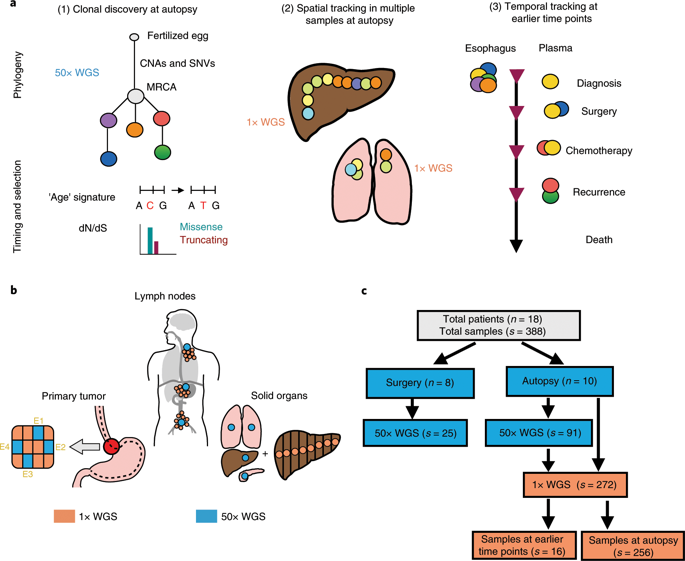Nature Genetics ( IF 31.7 ) Pub Date : 2020-01-06 , DOI: 10.1038/s41588-019-0551-3 Ayesha Noorani 1 , Xiaodun Li 1 , Martin Goddard 2 , Jason Crawte 1 , Ludmil B Alexandrov 3 , Maria Secrier 4 , Matthew D Eldridge 4 , Lawrence Bower 4 , Jamie Weaver 1 , Pierre Lao-Sirieix 1 , Inigo Martincorena 5 , Irene Debiram-Beecham 1 , Nicola Grehan 1 , Shona MacRae 1 , Shalini Malhotra 6 , Ahmad Miremadi 6 , Tabitha Thomas 7 , Sarah Galbraith 8 , Lorraine Petersen 7 , Stephen D Preston 2 , David Gilligan 9 , Andrew Hindmarsh 10 , Richard H Hardwick 10 , Michael R Stratton 5 , David C Wedge 11, 12 , Rebecca C Fitzgerald 1

|
The poor outcomes in esophageal adenocarcinoma (EAC) prompted us to interrogate the pattern and timing of metastatic spread. Whole-genome sequencing and phylogenetic analysis of 388 samples across 18 individuals with EAC showed, in 90% of patients, that multiple subclones from the primary tumor spread very rapidly from the primary site to form multiple metastases, including lymph nodes and distant tissues—a mode of dissemination that we term ‘clonal diaspora’. Metastatic subclones at autopsy were present in tissue and blood samples from earlier time points. These findings have implications for our understanding and clinical evaluation of EAC.
中文翻译:

基因组证据支持食管腺癌转移的克隆散居模型
食管腺癌(EAC)的不良预后促使我们质疑转移扩散的模式和时间。对 18 名 EAC 患者的 388 个样本进行的全基因组测序和系统发育分析表明,在 90% 的患者中,原发肿瘤的多个亚克隆从原发部位非常迅速地扩散,形成多个转移灶,包括淋巴结和远处组织——我们称之为“克隆散居”的传播方式。尸检时的转移性亚克隆存在于较早时间点的组织和血液样本中。这些发现对我们对 EAC 的理解和临床评估具有重要意义。











































 京公网安备 11010802027423号
京公网安备 11010802027423号